#Golf Course Architects
Explore tagged Tumblr posts
Text
I'm in day 2 of this big economics conference in Washington, and I attended two panels on cultural economics this morning. The very first paper was on golf course architecture and the age at which golf course architects do their best work, i.e., have their career peak as golf course architects. The economist giving this paper made the point that some people get into golf course architecture as a second career, and he had a PowerPoint slide with examples of famous golf course architects who'd done other things first: "law," "medicine," "finance." I had to make a conscious effort not to literally LOL at the last such example: "sybarite." 🤣⛳️🍆
0 notes
Text
Discover Exceptional Golf Course Architects Projects at Golf Design India
Explore a portfolio of remarkable Golf Course Architects Projects crafted by Golf Design India. From stunning landscapes to world-class amenities, each project showcases our commitment to delivering exceptional results that exceed expectations. Trust us to transform your vision into a breathtaking reality that stands the test of time. So if you want these services then contact us and for more information visit our website.

0 notes
Text
Pizá Golf Commissioned to design an Eco-luxury Wellness Golf Course at The Residences at The St. Regis Papagayo Resort
-This Wellness Golf Course will capture the luxury property’s commitment to wellness, and the Pura Vida spirit- SAN DIEGO, CA. – January 28, 2025 – Pizá Golf, a globally renowned architecture and golf course design firm, announces its commission to design a unique nine-hole golf course based on their award-winning Wellness Golf concept at the luxurious five-star rated The Residences at The St.…

View On WordPress
#FightAndGrind#SeeUOnTheNextTee#untilthenexttee#agustin piza#golf#golf course architect#golf course architecture#golf course design#Golf Equipment Reviews#golf Industry News#Golf News#golfers#golfing#hotels#piza golf design#sports#st. regis#travel#Until The Next Tee#until the next tee golf blog website#wellness golf
0 notes
Text
Do You Like 'Trees or No Trees' When Playing Golf?
Every golf course offers something special that all golfers can/should appreciate. The beauty of each course can be found on every hole and sometimes that beauty is subtle. Regardless of the layout of each course, its beauty is always in the eye of the beholder. As diverse as each golf course, what golfers find beautiful depends on so many factors it is hard to articulate. However, a simple…

View On WordPress
0 notes
Text






Trellick tower London.
Opened in 1972, it was commissioned by the Greater London Council and designed in the Brutalist style by architect Ernő Goldfinger
Goldfinger was known as a humourless man given to notorious rages. He sometimes fired his assistants if they were inappropriately jocular, and once forcibly ejected two prospective clients for imposing restrictions on his design.
A discussion on a golf course about Ernő with Goldfinger's cousin prompted Ian Fleming (the writer of James Bond) to name the James Bond adversary and villain Auric Goldfinger after Ernő—Fleming had been among the objectors to the pre-war demolition of the cottages in Hampstead that were removed to make way for Goldfinger's house at 2 Willow Road.
106 notes
·
View notes
Photo

Oheka Castle
Oheka Castle, built by the industrialist Otto Herman Kahn (l. 1867-1934), is one of the best-known luxury hotels of Long Island, NY, USA today. In its time as a private residence, it was the site of the kind of lavish parties which inspired the F. Scott Fitzgerald novel The Great Gatsby and continues to offer that same experience.
You step into the immense expanse of the foyer and there's the Grand Staircase ahead, wrought iron railings gracefully curving up from the stone landing on which fresh flowers rest on a marble altar. Your footsteps echo loudly across the stone floor and again up the steps to the second floor where a long carpet-runner muffles them as you pass by paintings of various sizes on the walls and statuary on pedestals, all quietly bathed in soft golden light.
Halfway down the hall, you open the door on your left and walk into a room ornately decorated with a silk embroidered couch beneath a gilt-edged mirror, flowers in a vase on a marble pedestal. Sunlight streams in through the window on the far wall and you move past the receiving vestibule with the couch to the bedroom area, draw back the drapes, and look down upon the manicured gardens and fountains. Off beyond the gardens you see Long Island Sound, and, in the silence, you can hear the deep booming of the ship’s engines and the long, low bellow of a tug's horn.
If you feel yourself a character in The Great Gatsby, well, you are not far off. Fitzgerald's novel is set on the so-called Gold Coast of America in the 1920s - the area of Long Island, NY where the wealthy elite built their summer homes between c. 1900 and 1920. Many of the most famous names - Vanderbilt, Phipps, Woolworth - had grand estates here and some have been preserved and are open to the public for tours. The one you have walked into is different from the rest in a number of ways, however, and, most notably, you can stay there. You are in Oheka Castle, formerly the home of investment banker and philanthropist Otto Herman Kahn which, today, is a luxury hotel in Huntington.
Time Travel to the 1920s
Although famously known as a "castle" the building is actually an early 20th-century French-style Chateau designed by the famous Olmstead Brothers Firm (which included Frederic Law Olmstead, the architect who designed New York City's Central Park) who also planned the intricate lawns and gardens. Originally an estate of 433 acres, the site is now comprised of only 23, most of it a golf course, though the French gardens and much of the statuary of the original estate remains.
A weekend at Oheka Castle is time travel back to the 1920s. The owner, Gary Melius, has carefully renovated and preserved the building to reflect the interests and tastes of the original owner. Vintage artwork hangs on the walls and one passes by statues and busts of Socrates, Plato, Epictetus, and Epicurus in the second-floor hallway. Walking down the winding back staircase from the second floor to the bar you feel like Gatsby about to throw another of his famous parties. The wood-paneled library, shelves lined with volumes, looks out through floor-to-ceiling French doors onto the gardens and the lawn and you cannot shake the feeling that Hemingway or Gertrude Stein or T.S. Eliot could stroll into the room any moment.
We were there for a wedding for which we would be staying the weekend and arrived on a Friday. Guests are encouraged to enter through the main gate though one can also access the grounds through a back road. A gatekeeper radios one's arrival and opens the gates. The drive up to the parking lot is impressive enough, passing manicured hedges, statues, carefully cultivated ivy on the archway, but once you pull in to the spacious parking lot, the impression of the hotel is stunning. Oheka is a commanding presence and even before you set foot inside you understand you are experiencing something exceptional.
On this trip, as on most, my wife Betsy and daughter Emily were along, and we all experienced the same sensation of stepping back in time as soon as the high wooden front doors were opened for us and we set foot in the foyer. The lighting from an opulent chandelier high overhead and wall sconces illuminates the grand hall in a soft blush of gold as from candles or oil lamps.
After checking in at the small office just inside the door, we were directed to our room on the second floor and took the ancient elevator up. It should be kept in mind that one is staying in a vintage hotel and the elevator will not operate at maximum 21st-century speed. Remember, you have stepped back in time; everything moved a little more slowly in the 1920s. The elevator opened on the long hallway decorated with artwork and sculpture under soft lighting, noted above.
Our room, previously described, was spacious with bathroom en suite complete with a vintage claw-foot tub and modern shower. There is a television and telephone in the room, neither of which we used, and WIFI is available and password-protected for guests. Modern amenities are never our priority when travelling, however, as we always opt for the time-travel experience in full when we can. Gazing out the window of our room down at the intricate gardens, fountains, and statues under the high blue canopy of a June sky, I thought of the original owner and the people of the past who had stood where I was standing.
Continue reading...
21 notes
·
View notes
Text


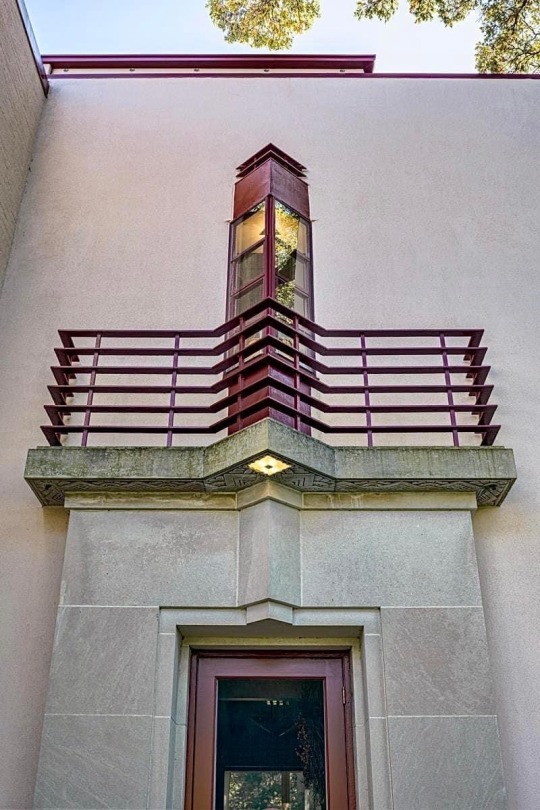
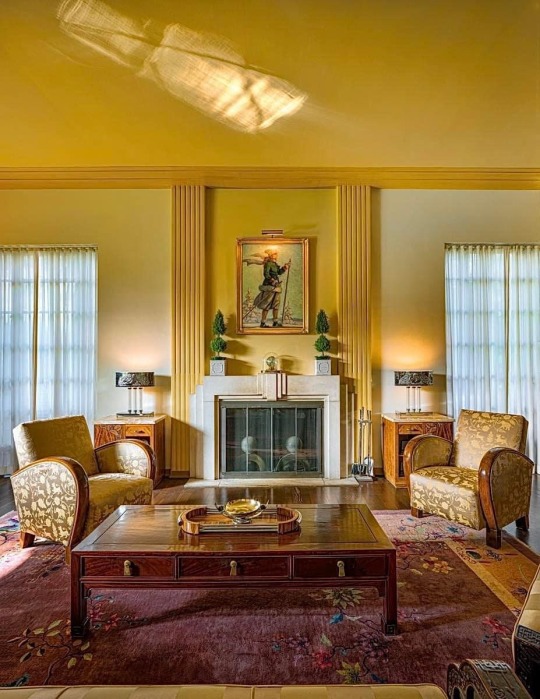

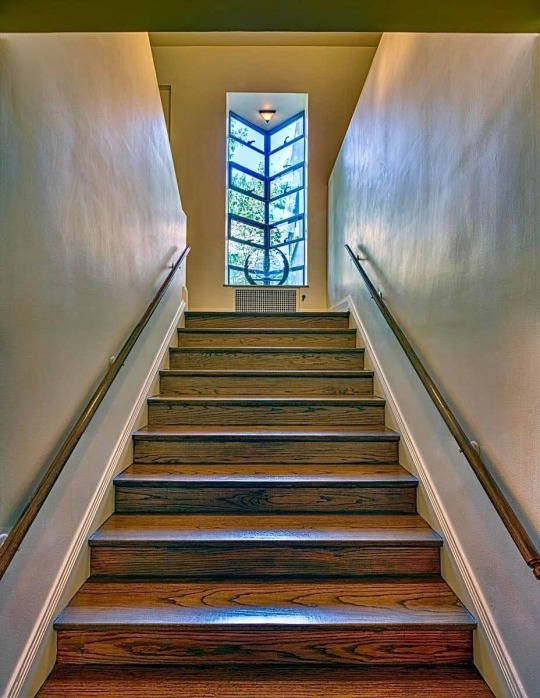
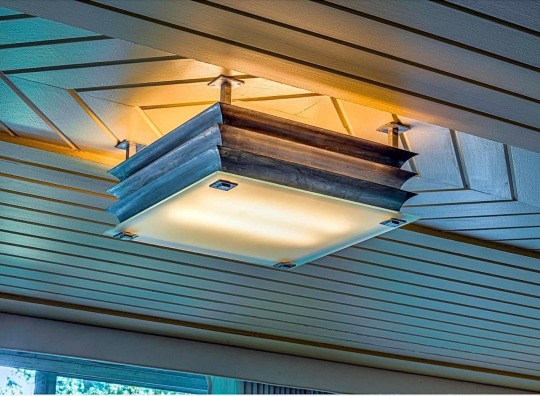
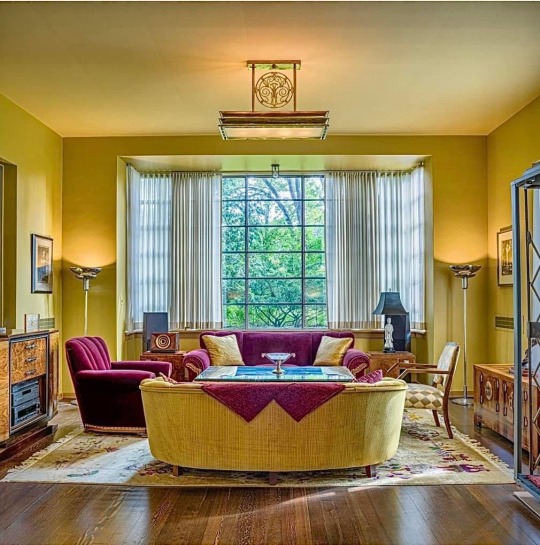

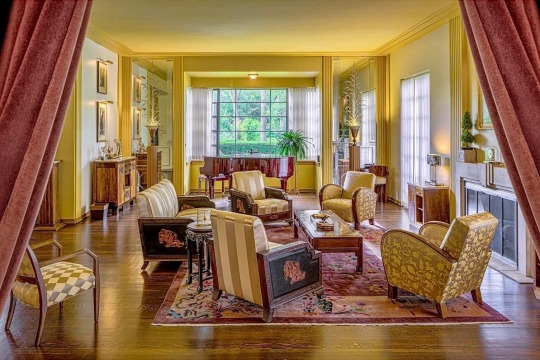
Colonel Robert Hosmer Morse House, built in 1932
1301 Knollwood Circle in Lake Forest, Illinois, USA
Architects: by Zimmerman, Saxe & Zimmerman
Built adjacent to a golf course, the 25-room mansion was built to entertain, with a locker room for golfing groups in the basement as well as several moderne drink-mixing closets scattered about the house despite its Prohibition Era origin.
Photo credit: James Caulfield's Architectural Photography Archive
257 notes
·
View notes
Text





The Country Club (The Board of Trade Golf & Country Club)
You can see the location by checking out the video!!
youtube
Moving along, we go downstairs and check out the large maze that was the locker room area!!
The Board of Trade Golf & Country Club, was a distinguished golf facility located in the rolling hills of the Humber Valley in Ontario, Canada. It featured 45 holes that were designed by architect Howard Watson, an east and west course, as well as a 9 hole executive course. The club opened in 1965 and included a sprawling mid-century modernist clubhouse.
The courses have played host to the Carling World Open, a major international tournament, as well as the du Maurier Classic, an LPGA major.
In 2017 the large 290 acre property was sold to a development company. The property is currently being redeveloped into a new mixed use community, including mid rise apartments, townhouses and single detached homes. Due to a large portion of the property residing within a floodplain, roughly two thirds of the land has been allocated for public parks.
There was a historical assessment done on the clubhouse, a mid-century modernist piece of architecture built in the mid-60's, but it was deemed it wasn't significant enough to be saved or repurposed. The golf course ceased operations after the 2022 season, and the clubhouse was demolished in early 2024
The Country Club of the Toronto Board of Trade was renowned for its challenging courses and its role in Canadian golf history. Its legacy endures through the memories of its members and the tournaments it hosted, contributing to the rich tapestry of golf in Ontario.
#abandoned#urbex#urban exploring#urban exploration#bandos#abandoned buildings#abandoned places#forgotten#forgotten buildings#forgotten places#abandoned country club#abandoned country clubs#abandoned golf course#abandoned golf courses#Youtube
9 notes
·
View notes
Text
english translation of this paywall-hidden interview:
find the german version here
Jamal Musiala is only 21 years old, but he is already a key player for the German national team. He has only just moved into his first own apartment. A conversation about growing up in the public eye and dreams outside of sports.
After training with the national football team, Jamal Musiala arrives in high spirits for his interview with WELT AM SONNTAG at the Adidas Homeground, the training facility of the German Football Association in Herzogenaurach. Inside the building, golf bags are lined up for the players to use during their free time. Musiala examines them closely. "I need to stay up to date when it comes to equipment," he says with a smile.
A few days later, he will play an outstanding international match, scoring one goal and assisting three more in a 5-0 victory against Hungary in the Nations League.
WELT AM SONNTAG: Mr. Musiala, do you play golf?
Jamal Musiala: Yes, but I haven’t played in a long time. Thomas Müller and Harry Kane, my teammates at FC Bayern, are very good golfers. Thomas is the better of the two – at least that's what he says (laughs). So I definitely need to practice again to get on their level.
WAMS: There’s a stereotype that golf is more popular with people over 30. Do you feel too young for this sport?
Musiala: Not at all. Golf is just fun.
WAMS: You’ve already won the German Championship four times, two European Championships, played in a World Cup, appeared in 34 international matches, and over a hundred games for FC Bayern – and you’re only 21. Recently, you moved out of your mother’s house.
Musiala: Yes, I moved from my mother’s house into an apartment. It’s a bit different now, but I like it. I really enjoy having my own peace, as we say in English, my own space where it’s quiet. What I really miss, though, is my mom’s delicious food. But I’ve found a good solution – and I enjoy cooking myself now and then.
WAMS: Are you a good cook?
Musiala: Not at all (laughs). But, like with golf, I just enjoy it.
WAMS: But you can manage to make your beloved Maultaschen?
Musiala: Yes, they’re easy. But I can’t eat them too often.
WAMS: At the Euros, you were the top scorer with three goals, along with five other players. Have you set up a trophy room in your first apartment yet?
Musiala: I don’t have much space, so I’ve left all the trophies at my mom’s house.
WAMS: Others your age are just moving into shared apartments, studying, or starting apprenticeships. You debuted in the Bundesliga at 17. How much do you actually experience the everyday reality of your generation?
Musiala: I’ve been in the football world from a young age, so I don’t have many friends outside of sports. I’d like to have more, but you can’t force it. Friendships are important to me. As a teenager, I was in the FC Chelsea Academy, and that’s where friendships formed that have lasted to this day. That means a lot to me.
WAMS: If you hadn’t become a footballer, what do you think you’d be doing today?
Musiala: Funny that you ask, because I was just thinking about that a few days ago. I would definitely do something creative. Maybe study architecture or work as an architect. I always enjoyed drawing in school.
WAMS: Your first own apartment, your fifth season with Bayern, your fourth year in the national team – your nickname "Bambi," which teammate Leroy Sané gave you because of your skinny legs, no longer really fits. Does this current phase of your life feel like growing up?
Musiala: I don’t mind the nickname Bambi; anyone can still call me that. Of course, I’ve grown with experience and I’m no longer the Bambi player. I’ve been through a lot at a young age, and hopefully, there will be many more games and titles to come. Consistency is key, and I do everything I can to maintain that. I rely on good routines and take care of my body.
WAMS: It’s said that you also do a lot of individual training in addition to your team practices.
Musiala: That basically started in our garden when I was a child. My dad played football himself and always told me, "Your coaches will do everything they can to help you become a pro, but the extra effort, the extra miles, you have to do yourself. No one will force you to do that. That drive has to come from within." I thought that message was cool and it made sense. I still take it to heart and always think about what I can do to take another step forward. No matter how many titles I win or how much my status changes, my work ethic and mentality won’t change. I’ll always look for ways to improve and stay open to learning and growing. This mindset has always worked well for me.
WAMS: You also do neuro-athletic training. What exactly do you train?
Musiala: It’s mainly about stability and movement. We train my eye speed, which is very important for my turning movements and positioning on the field. The faster my eyes move, the quicker I can anticipate. The first touch of the ball is often decisive, and this training helps me execute the ideas I have on the pitch.
WAMS: You mentioned your routines earlier. What do they look like?
Musiala: For example, I have a set routine on matchdays. I always take a nap in the afternoon, and then I recite my affirmations. I always step onto the pitch with my right foot. And if I’ve scored a goal – whether for Germany or Bayern – I wear the same pair of boots in the next match until I stop scoring (laughs).
WAMS: What affirmations do you say?
Musiala: They’re affirmations that I’ve tried out and developed over time, and they work well for me.
WAMS: Can you share one with us?
Musiala: Sorry, that’s like making a wish when blowing out birthday candles – you’re not supposed to tell anyone.
WAMS: Who is the most important advisor in your life?
Musiala: I listen a lot to my coaches and teammates, and to the feedback from my family and close friends.
WAMS: Young adults your age are often referred to as the “TikTok generation.” Do you check the feedback on social media?
Musiala: Not much. After a match, I do look at the comments sometimes. Using social media is normal, I think, but over time I’ve learned to distance myself from it. I don’t need it. Negative comments can bring you down.
WAMS: So you haven’t left an angry or praising comment on your idol Stephen Curry’s social media accounts yet?
Musiala: (laughs) Now that you mention it, maybe I’ll do that with a fake account. No, Curry knows how good he is. What he did at the Olympics was incredible. He represents top performance and entertainment. And he never makes unnecessary moves just to show off. He always focuses on the team. That’s the standard I want to live up to as well. I want people to come to the stadium and enjoy watching me, while I always give everything for the team. I can learn a lot from Curry.
WAMS: Do you watch a lot of NBA?
Musiala: Every Warriors game. I’m a real fan. I’m really excited for the season to start again in October. I thought the Warriors would make a few more trades, get a few more players, but okay – we’ll see how the season goes.
WAMS: Teammates and coaches describe you as very down-to-earth. Yet your rise from talent to star was rapid; over five million people follow you on Instagram, and you’re seen as the future of German football. How do you manage to stay grounded?
Musiala: That has a lot to do with how I was raised and how my parents brought me up. I just stay the way I am – open and respectful to people. You always get that back. Fame and money might change the lifestyle a bit, but not my values and attitude.
WAMS: With Thomas Müller, Manuel Neuer, Ilkay Gündogan, and Toni Kroos having retired from the national team, are you now expected to step up as a leader? Is that what coach Julian Nagelsmann is expecting of you, despite your young age?
Musiala: At the Euros, I realized that I can take on more responsibility. But all of us have to take responsibility on the pitch. We help each other. The more experience I gain, the more I’ll grow into a leadership role.
WAMS: Nagelsmann recently announced the new team council, and you’re not part of it – which record national player Lothar Matthäus criticized.
Musiala: That’s totally fine with me. We have a very open relationship with each other and with the coaching staff. Whenever I want to express my opinion or it’s asked for, I’ll say it. I don’t have to be part of the team council to be a leader. I’ve known Julian for quite a while, and we get along really well.
WAMS: After the quarter-final exit at the Euros in Germany, Nagelsmann set the goal for the 2026 World Cup: "We want to become world champions." How realistic is that?
Musiala: We can definitely win the title in 2026. With a bit more luck, we would have at least made it to the semifinals at the Euros. As a team, we've made good progress recently and will continue to develop over the next two years. We’ve learned from the Euros and want to go far in the World Cup.
WAMS: What are your personal goals for the coming months?
Musiala: I always want to be better than in the previous season. I want to further improve my strengths and work on the things I didn’t do so well recently.
WAMS: What are those things?
Musiala: Decision-making – making the right decision quickly on the field; there’s still room for improvement. That’s crucial in football. I also want to get into more scoring positions. That worked well during the Euros. I definitely want to get into the penalty area more often. That’s why I was very happy to score a “simple goal” recently for FC Bayern in Wolfsburg, where I was in the right place to tap it in.
WAMS: You once mentioned a principle for your play: no dribbling in your own half.
Musiala: That’s not always the case, but it's generally true. Recently, at Bayern, I’ve been positioned deeper during build-up play, so sometimes you need to dribble to start an attack and pull an opponent out of position. I do what the situation requires. In football, anything can happen, something unexpected. Intuition and anticipation are crucial.
WAMS: You were influenced by English football as a youth – and you’ve moved around quite a lot in your young life…
Musiala: … very often, yes.
WAMS: You were born in Stuttgart, then moved to Fulda because your mother Carolin began her studies there. From there, she took you to Southampton for an Erasmus program, then back to Fulda. Chelsea scouted you, and you moved to London – and eventually to Munich when you joined Bayern. Where is home for you?
Musiala: That’s something we’ve often asked ourselves within the family. For me, home is where I live. And where my family is. They are the most important thing in my life. We have a very close bond. That will never change. I have a younger sister and a younger brother. The fact that we siblings tease each other for fun will never change either.
WAMS: Are you already thinking about starting your own family?
Musiala: I’ve always been a family person. But I haven’t thought about starting my own family yet. I don’t have a timeline for that. I like my life the way it is right now. Football, occasionally going out with friends – it’s perfect for me at the moment.
WAMS: One of your best friends is Joshua Zirkzee from Manchester United, and you were recently on vacation together in the USA. He recently told a fan that he tried to convince you to move to United.
Musiala: Friends always joke and dream about playing on the same team one day. The teasing goes both ways: I also told Josh to come back to Bayern. But you shouldn’t take that too seriously.
WAMS: Your contract with FC Bayern runs until the summer of 2026. How much would you like to play for a global club abroad someday? Your friend Jude Bellingham moved from Borussia Dortmund to Real Madrid.
Musiala: I’m very happy at FC Bayern and fully focused on our goals with the club and the national team. I don’t give much thought to where I’ll be playing in five years. In the football world, things can change quickly.
WAMS: Mr. Musiala, what is a dream you have for your life outside of sports?
Musiala: I would love to go on a world tour. You need time for that, though. Between seasons, I only have a maximum of three weeks of vacation, and that’s not enough. It was exciting to visit the USA for the first time. For example, I was fascinated by Las Vegas. I’m also very interested in many Asian cities. Discovering countries and cultures is fun and broadens your horizons. Someday, I’ll travel a lot. In ten to fifteen years, I’ll start planning that more seriously.
20 notes
·
View notes
Text

Golf Design India specializes in the renovations of existing golf courses, enhancing playability, aesthetics, and sustainability. Our expert team modernizes layouts while preserving the course’s unique character, ensuring a refreshed and challenging experience for players.
#golfdesign #renovation
0 notes
Text
Purposeful Golf announces long-term lease for National Pines
TORONTO, Ont. (April 17, 2024) — Purposeful Golf is excited to announce it has entered into a 21-year lease agreement to manage National Pines Golf Club in Innisfil, Ont., effective November 2024. The announcement follows Purposeful’s 2023 acquisition of The Ridge at Manitou in McKellar, Ont. National Pines will continue to operate as a private, member-based club, and Ridge at Manitou will…

View On WordPress
#FightAndGrind#SeeUOnTheNextTee#untilthenexttee#canadian golf news#golf#golf Industry News#Golf News#golfers#national pines golf club#purposeful golf#the ridge at manitou#thomas mcbroom golf course architect#Until The Next Tee#until the next tee golf blog website
0 notes
Text
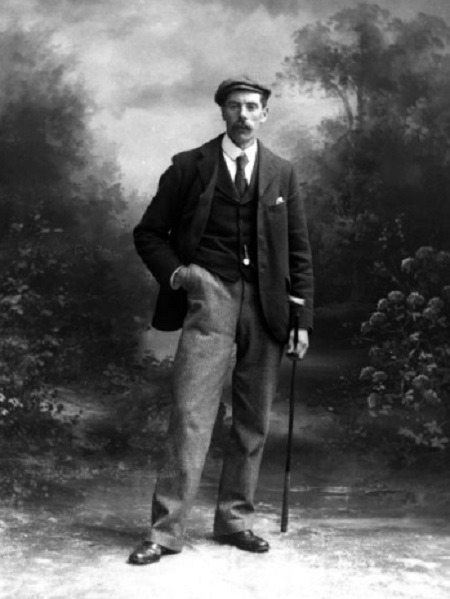



27th November 1950 saw the death of the professional golfer and golf course designer James Braid.
Born at Earlsferry in the Kingdom of Fife James Braid took up golf at an early age and played on the lovely links at Elie.
A carpenter by trade, Braid turned his skilled hands to making and repairing clubs before leaving Scotland to begin club-making at a store in London. Seizing every spare moment to play the game he loved, he steadily improved and, when 26, accepted a job as the professional at Romford Golf Club on the outskirts of London.
As a golfer e won The Open Championship in 1901, 1905, 1906, 1908 and 1910. In addition, Braid won four British PGA Matchplay Championships (1903, 1905, 1907 and 1911), as well as the 1910 French Open title. He was also runner-up in The Open Championship in 1897, 1902, 1904, and 1909. His 1906 victory in The Open Championship was the last successful defence of the title by a European until Pádraig Harrington replicated the feat in 2008. As well as the five Open wins he finished in the top five a further 11 times!
He also founded the Professional Golfers' Association and, in the midst of all his success, moved to Walton Heath, a new course to the south of London, where he remained the pro for more than 40 years until his death in 1950. While at Walton Heath, Braid found time to both write about golf and design or improve more than 200 courses throughout the U.K. Some such as Gleneagles, Carnoustie, Southport and Ainsdale, Boat of Garten and St. Enodoc are rightly famous, while others such as Aberdovey, Berkhamsted, North Hants and Goodwood are perhaps less well known, but still enjoyed nowadays by exponents of the sport.
As well as playing golf and designing courses James Braid also found time to write about it, he first articulated his philosophy in a book called "Advanced Golf," which was published in 1902. Two chapters are devoted to design and are quaintly entitled "The Planning of Course" and "The Character and Placing of Teeing Grounds, Bunkers and Putting Greens." Golf Guide, The Ladies Field Golf Book in 1908 and , How to Play Golf was in 1910. There is also a book about all the courses Braid designed as an architect titled "James Braid and his 400 courses."
Bernard Darwin’s biography James Braid was published in 1952. Darwin knew Braid for over fifty years and offers some keen insights into the man who is described as having “wisdom and a deep and essential kindness.” Regarding Braid’s ability to focus, Darwin describes him, “studying his putts as if the fate of empires depended on them,” even in casual rounds.
Braid disliked travel overseas, very rarely left the British Isles, and never traveled outside Europe, hence no American titles. But he did design two 18-hole golf courses for the Singapore Island Country Club in Asia, using topographic maps to plan his layouts there, which were then constructed to his orders.
Courses in the pic are, in order, The King's course,Gleneagles, Nairn Golf Club, Brora Golf Club, where you have some interesting hazards to play around! Championship course, Carnoustie Golf Links and Craigmillar Park Golf Club.
James Braid died on this day 1950 in Kensington and is buried at Saint Peter's Church Walton-on-the-Hill, England, he was 80 years old.
I like the epitaph on his grave, it reads , ‘He had many opponents but no enemies’
12 notes
·
View notes
Text
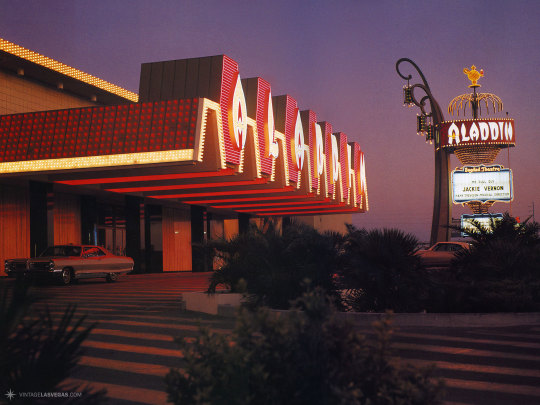
Tally Ho / Aladdin / Planet Hollywood
Aladdin opened in 1966 with one of the Strip's first neon-enhanced porte-cochéres, a freestanding sign featuring a revolving, three-sided marquee, topped with an "Aladdin's Lamp," designed and fabricated by YESCO.
Timeline.
Tally Ho ('62-'65)
'61: Edwin S. Lowe announces plans for Tally Ho non-gaming hotel. In the 40s the land was owned by locals Salton, Rose, and Goldberg. (Alexander & Rebecca Salton, founding members of the Las Vegas Jewish community.)
'62: Dec. 24, Opening of Tally Ho, hotel and country club with 9-hole golf course. 322 of the 450 rooms open during “preview opening” in Dec. The hotel was alternately spelled Tally Ho, Tally-Ho, and Tallyho.
'63: Oct. 11, Tally Ho closed. “Ed Lowe made no excuses … admits he was dead wrong about a no gambling luxury hotel.” (Hertz, RJ 10/13/63)
'63: Oct., Norman Kaye and Frank Windsor operate the Tally Ho golf course.
'63: Oct.-Dec., The hotel is sold to Kings Crown Inns of America, represented by Floyd and Beryl Cook, Donald Bolinger (Cooks Brothers Trusts, Indiana). Under lease to operators Edward Nealis, Charles Luftig, and partners, Kings Crown Tally Ho's hotel, lounge, and restaurants reopen in Dec. (Duke, RJ 12/20/63)
'64: Construction of a showroom and casino begins in Fall, misses New Year's Eve opening deadline. The showroom and casino are completed in '65, ultimately never opened. (RJ 4/8/64, RJ 5/18/65)
'65: Nealis heads 18 casino applicants of Tallyho Operating Co. who are unable to get approval from Nevada Gaming Control Board (GCB). In later years Jimmy "the Weasel" Fratianno of the Los Angeles crime family claimed he owned a piece of the Tally Ho and was to run the casino. (AP 2/17/65, RJ 11/25/84, Mob Museum 12/8/2017)
'65: Apr. 1, Tally Ho closed for the second time after King's Crown files suit against Tallyho Operating Co. for unpaid rent. Tenants are evicted, property put in control of the owners.
'65: Dec., Tally Ho bought by Milton Prell (Prell Hotel Corp.) from The Cooks Brothers Trusts.
Aladdin ('66-'97)
'66: Aladdin announced. Drawings for redesigned casino and proposed hotel tower unveiled early in the year. Martin Stern, architect. (RJ 1/2/66, RJ 1/17/66)
'66: Mar. 31, Aladdin opened. Freestanding sign and the Strip's first neon-enhanced porte-cochère by YESCO. Primary owners M. Prell, G. Gilbert, and S. Krystal, all former members of Sahara-Nevada Corp. Comedian Jackie Mason opens the 500-seat Baghdad Theatre.
'66: Dec., Prell stops $75k/month payments on the Aladdin and asks that the price be cut. The trustees agree to reduce the sale price to $5.5M. (Dayton, 4/20/72)
'67: Sep. 26, Milton Prell suffers a debilitating stroke which removes him from Aladdin management. (Dayton, 4/20/72)
'68: Stockholders of Prell Hotel Corp. vote to merge with Parvin-Dohrmann Co., leading to Parvin-Dohrmann take-over the Aladdin in Apr; approved by GCB in Jun. Later in Dec., Parvin-Dohrmann's Delbert Coleman becomes the sole gaming license holder of Aladdin and Fremont hotels. (RJ 6/20/68, RJ 11/14/68, RJ 12/12/68)
'68: Sep., 28, from a report, after the Prell & Parvin-Dohrmann merger was completed, "Milton Prell, by this time paralyzed, was told by the new management he had two weeks to get out of the Aladdin." (McKnight, Alexander. Journal Herald, 4/20/72)
'70: Parvin-Dohrmann adopts the new name Recrion, and strips the firm of all its holdings except for its three Las Vegas hotel-casinos: Aladdin, Fremont, and Stardust.
'71: Oct.-Dec., Recrion announces sale to Sam Diamond, P. Webbe, R. Daly, D. Aikin as Aladdin Hotel Corp. Diamond announces plans for hotel tower.
'71: Entertainment director James Tamer is involved in secretly managing the casino and directing the skim, according to later conviction.
'74: Aladdin investigated by GCB for issuing comps to organized crime figures.
'74: Groundbreaking for the “Tower of Majesty” high-rise, and theater. Lee Linton, architect. Years later in '83, Linton and Aladdin attorney Sorkis Webbe are each convicted of tax fraud in relating to a kickback scheme during the '74 expansion.
'76: Jul., Tower and Theatre for the Performing Arts opened; new porte-cochère by Charles Barnard, Ad-Art; original sign replaced; all financed by Teamsters Central States Pension Fund loan.
'76: Mae Ellen George buys 24% of the hotel, relying on advice of Tamer.
'78: Aug. 3, Detroit federal grand jury indicts Tamer, Aladdin GM James Abraham, Aladdin casino manager Edward Monazym, and Charles Goldfarb (denied a license in ’71) of conspiring to allow hidden owners to exert control over the resort. Owners of the Aladdin at this time are Webbe (34%), Diamond (23%), Mae George (19%), Daly (14%), John Jenkins (8%), and George Morse (2%). (RJ 8/3/78)
'79: Mar. 13, Tamer, Abraham, Monazym, and Goldfarb convicted.
'79: Aug., GCB closes the resort; U.S. District Judge Claiborne opens it hours later, “until a mob-free buyer could be found.” (German, RJ 9/20/2021.)
'80: Jan., Ed Nigro gains a court-sanctioned takeover of the Aladdin after he and Johnny Carson sign an agreement to buy the property for $105M. The deal falls through.
'80: Jul. 10, GCB revokes Aladdin's license and the casino is closed; hotel remains open.
'80: Oct. 1, Casino is reopened after Ed Torres and Wayne Newton buy the Aladdin for $85M.
'82: Jul, Torres buys Newton's shares of the Aladdin.
'84: Feb., Aladdin placed under bankruptcy protection after a Teamsters Pension Fund forces foreclosure.
'85: Jan. 22, Ginji Yasuda buys the Aladdin for $54M; casino closed during Yasuda licensing.
'87: Apr. 1, gaming reopens.
'89: Aug., Yasuda, failing to reveal the source of millions in loans, loses his gaming license; Aladdin forced into bankruptcy.
'89: Sep., Court appointed trustee Jack Fidelman, and WDT Associates (Wm. and Tim Dougall, Larry Bertsch) take over operating the hotel. Aladdin remains in bankruptcy through the early 90s.
'91: Jun., Property title transferred to Bell Atlantic Tricon Leasing Corp when no buyers meet the minimum bid.
'92: Jun., Aladdin emerges from 3-year bankruptcy, control is given to Joe Burt and his JMJ management team on a 12-year lease with Bell Atlantic Tricon.
'94: Dec., Jack Sommer, Signman Sommer Family Trust, buys the Aladdin for $80M. "When the family trust sold a major New York property in '94, Sommer needed to find a real estate investment for the proceeds to avoid substantial capital-gains taxes. The Aladdin was on the market at the time." (Simpson. RJ 8/13/2000.) Other potential buyers included Donald Trump.
'97, Nov 25: Aladdin closed. A new hotel-casino to be built on the 35-acre parcel.
'98, Apr 28: Aladdin tower demolished. Former Tally Ho rooms later demolished; Theater remains.
Aladdin (2000-2007) Planet Hollywood (2007-)
2000: New build of the Aladdin. Mall opens 8/17/00, hotel and casino delayed, opening 8/18/00. Cost: $1.1B.
2001: Sep., Aladdin files for bankruptcy.
2003: Aladdin sold for $635M to OpBiz investment group led by Planet Hollywood CEO Robert Earl. Sale finalized 9/1/2004.
2007: Apr. 17, renamed Planet Hollywood.
2009: Harrah’s Ent. purchases part of the $860M mortgage, takes full ownership in Feb. 2010. Harrah’s later rebranded as Caesars Entertainment.
Photos of Tally Ho | Photos of the Aladdin
Headline photo: Undated, circa '68, from The Magic Sign by Charles Barnard.

Circa Feb.-Mar. 1966: The hotel was open before the casino. Installation of the sign is beginning. Photo: Las Vegas News Bureau.




Mar. 1966: Sequence of photographs showing YESCO’s revolving, three-sided Aladdin pylon structure being pieced together by dual cranes ahead of their opening on the 31st. Ad-Art collection, from Charles Barnard’s The Magic Sign.

Undated, Las Vegas News Bureau.

3/31/66 – Opening night. Four men holding scissors are Bill Braire, Las Vegas Mayor Oran Gragson, Milton Prell, Las Vegas Sun Publisher Hank Greenspun. Las Vegas News Bureau, LVCVA Archive.

“Aladdin Casino was the first Las Vegas hotel to integrate major sign elements and neon into its porte-cochère. Sign modules were incised into the leading edge of the projecting canopy and wrap-around grids of incandescent lamps followed these contours back to the entry.” - Charles Barnard, The Magic Sign. Photo: Las Vegas News Bureau.

Postcard c. '66-'68

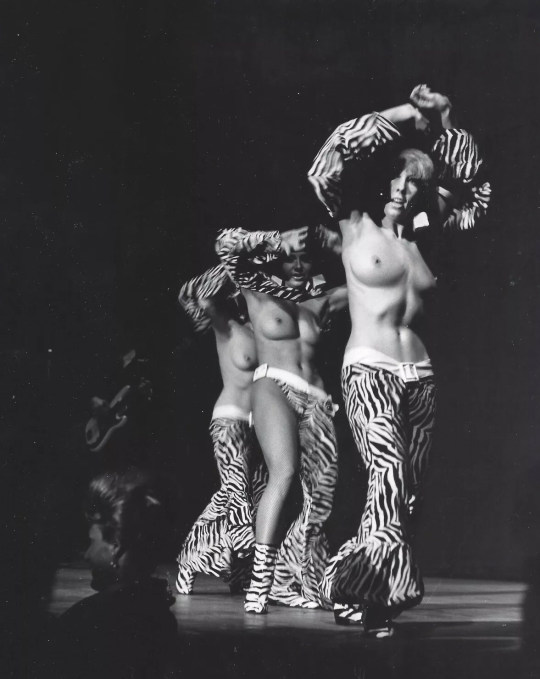
Showgirls at the Aladdin, 1966. Las Vegas News Bureau.

Button for Grateful Dead at the Aladdin, 8/31/81
Timeline sources.
Previous landowners: C.D. Baker Map of Las Vegas Valley ’40; Alexander Salton. UNLV Special Collections & Archives.
Tally Ho: Tallyho Preview Attracts 3500. Review-Journal, 12/28/62; Tallyho Hotel Closes. Review-Journal, 10/11/63 p1; Murray Hertz. Future of Tallyho Raises Questions. Review-Journal, 10/13/63; Gordon Kent. Tally-Ho Hotel Sold. Review-Journal, 11/1/63; Forrest Duke. New Tallyho Sale Deal. Review-Journal, 12/20/63; Tallyho Plans $1 Million Show. Review-Journal, 4/8/64; Associated Press. Gaming Board Refuses Tallyho Casino License. Review-Journal, 2/17/65 p1; G. Kent, F. Duke. Strip Hotel Closes. Review-Journal, 4/1/65 p1; Tallyho Sues Owners. Review-Journal, 5/18/65 p1.
Tally Ho and Aladdin sales covered in a series by Keith McKnight and Andrew Alexander for The Journal Herald, Dayton OH. Welsh confirmed with crime figures. Journal Herald, 4/20/72; Firm with crime ties linked to casino deal. Journal Herald, 4/21/72.
Aladdin: Associated Press. Gamers Approve. Review-Journal, 6/20/68 p1; Chicagoan Asks License To Run Two Local Casinos. Review-Journal, 11/14/68; Casino Deal Okayed. Review-Journal, 12/12/68; Associated Press. Firm adopts new name: Recrion Corp. Reno Gazette Journal, 12/14/70; Lou Miller. Aladdin Hotel sold. Review-Journal, 11/8/71; Jerry Ralya. New Aladdin Corporation seeks license. Review-Journal, 12/29/71; Aladdin execs indicted. Review-Journal, 8/3/78; AP. Las Vegas architect sentenced to prison. Review-Journal, 3/8/83; AP. Webbe convicted. Review-Journal, 6/19/83; Jane Ann Morrison. LV Casinos Targeted in Money Laundering. Review-Journal, 11/25/84; Aladdin Hotel's history spans 30 years. Review-Journal, 1/5/94 p3; Dave Palermo. Aladdin Hotel finally sells. Review-Journal, 12/9/94 p1; History. Review-Journal, 11/23/97 p14; Jeff Simpson. Aladdin owner faces music. Review-Journal, 8/13/2000; Chronology of the Aladdin hotel-casino. Las Vegas Sun, 8/18/2000. John L. Smith. Sharks in the Desert. Barricade Books, 2005; David Schwartz. Jimmy The Weasel Fratianno. themobmuseum.org, 12/8/2017; Jeff German. The Genie in the Lamp, and Close the Place Down. Review-Journal, 9/20/2021.
93 notes
·
View notes
Text

Then and Now: Circa 1920’s and 2024
The Eseeola Lodge in Linville in Avery County, North Carolina was established in 1888. The original inn burned in 1936 and was replaced by the Eseeola Lodge which is still open today.
The Eseeola Lodge History: Sometimes history tells a funny story. Back in 1888, mining entrepreneur Hugh MacRae envisioned the Linville, NC area as a busy manufacturing hub with hundreds of buildings lining the streets and lots of hustle and bustle. Thankfully, he came to learn that Linville's potential was in its existing beauty, not future industry. People were falling in love with Linville because it was already a special place.
Travelers flocked to the area for the cool summer temperatures and friendly people. MacRae abandoned his initial plans and the town slowly morphed into a resort community. And, at the center of it all was - and still is - The Eseeola Lodge.
Work was completed on the original Eseeola Inn in 1891, a large Queen Anne-styled building. The Inn hired a baker and chef from New York for that summer, purchased the finest linens and china money could buy and created a first-class dining experience for guests that came to Linville for some rest and relaxation.
There was plenty to do at the Eseeola Inn. Guests could take a buggy or horseback ride through the mountains or enjoy trout fishing from the banks of the Linville River. Or they could indulge in a rousing croquet match, a few sets of tennis, archery, billiards or lawn bowling. The following year, the Eseeola Inn built a nine-hole golf course, giving guests one more activity to choose from.
Fast forward several years. As the season got underway in the spring of 1936, a fire broke out in the kitchen and the entire resort was destroyed. Guests were accommodated in the Chestnut Annex, named for its unique - and now irreplaceable - chestnut bark shingles, selected by world renowned architect Henry Bacon. Because it had become so popular by guests of the resort, the company decided to add a lounge, dining room, and kitchen to the annex, and officially renamed it The Eseeola Lodge.
The Eseeola Lodge is all about stately elegance. Although there are only a total of 24 rooms and suites, their level of service is impeccable. The rooms may not be as large as some of the national chains however they are very warm and inviting, and very well appointed. Resort guests can also enjoy other features of The Eseeola Lodge including the library, lounge and bar, or wander around the numerous buildings that make up the property and take in the surrounding beauty of the grounds.
On property you'll find a day camp for kids, which provides adults just enough time to indulge in a luxurious spa treatment. If you're so inclined, head over to the pool and swim a few laps.
You can also take advantage of the tennis courts and exercise and fitness room. If you're an outdoor adventurer, you can play a round of croquet or go canoeing and fishing. There's still plenty to do.
#linville north carolina#avery county nc#averycounty#1920s#appalachian#north carolina#appalachian mountains#appalachian culture#western north carolina#appalachia#the south#nc mountains#appalachian history#old building
9 notes
·
View notes
Text
Random Corporate Clash Headcanons, Playing Corporate Clash Edition
Let's ignore how long it's been since I made these, okay? And ignore the massive 4th wall breaking
ALSO special appearance from some mgrs I normally wouldn't write for
Duck Shuffler
🎰He doesn't really know how to strategize, so he picks random stuff and hopes for the best
🎰Absolutely LOVES the trolley
🎰Loves to talk to basically anyone he comes across and try to make friends with them
🎰Often gets indecisive about what to do next, so he spins his slots to decide
Prethinker
🧠Okay, usually his intelligence is laughable and fun to make fun of, but this guy is a professional no life. He knows EVERYTHING about the game
🧠Tries to reach 150 laff as soon as possible and has absolutely ZERO fun with the game
🧠 Doesn't make friends and only talks if he's giving out battle strategies, which is... basically every round of battle even if it's just a 2 story building in Barnacle Boatyard
🧠He's kinda elitist, too
Derrick Man
🛢️Doesn't really play that often since he's not a gamer
🛢️I can't ever imagine him getting much further than The Brrrgh cause he just. DOESN'T PLAY.
🛢️Despite his inexperience and infrequently logging in, he's actually pretty decent at the game
🛢️Collects manager rewards and hoards them. He needs them all
Deep Diver
🫧He's the kind of person to not leave Toontown Central until he's maxed all of his activities, has overpowered gags, and also started a club that's now at level 100 and has like 50 members
🫧Very slow and methodical with her gameplay- she explores every little nook and cranny before moving on. Has all racing, golfing, and fishing trophies kinda thing. Gets all achievements kinda thing
🫧Loves to set up in battles and take his time with them. Yes, he will struggle a lot with Pacesetter
🫧She LOVES fishing, by the way
Rainmaker
⛈️Doesn't really enjoy combat very much and prefers to play Toono and such
⛈️Also really likes the trolley and makes tons of trolley groups
⛈️Wouldn't progress much further than Mezzo Melodyland, probably
⛈️Tries to make friends, but others tend to find her annoying or even rude so she doesn't make very many
Land Acquisition Architect
🚦Tries to get some friends together to play with him
🚦Behind the screen, he is absolutely having a temper tantrum over EVERYTHING. Be it a gag missing or someone doing a less optimal play, he's screaming
🚦But in the game he's like SUPER DUPER NICE and makes no outward show of how angry he actually is
🚦If you befriend him, you're getting constant invites to like everything he does
Gatekeeper
⚔️Tries to max in the most efficient way possible
⚔️Will try to show off all her boss loot, but of course only in stylish ways
⚔️Kind of an elitist, definitely pretty rude
⚔️Likes to sit out of bounds doing nothing. Alternatively, she sits in front of the CFO doors or in DDL doing nothing just to show off her TTR elitist roots
Witch Hunter
🔱He says he wouldn't play such a childish game and says he's just gonna uninstall it
🔱Five minutes later he's in an OCLO. Also, he has 150 laff so clearly it's not too childish for him
🔱He's an elitist
🔱Would 100% quad Toon and try to act like they're not his alts, even going as far as giving them their own "typing quirks" and having fake conversations
Public Relations Representative
🧱Can't really use SpeedChat+ effectively since he glitches around and makes lots of typos
🧱Frequent misclicks and missteps
🧱Will not survive OCLO or Pacesetter very often
🧱Surprisingly loves to play the game and accidentally no lifes to 150 laff
Bellringer
🔔Loves to destroy Cogs with perfect damage whenever possible, for some reason
🔔His estate would be VERY cozy, which is honestly a huge feat considering its current in-game state makes it... very lonely and desolate by nature
🔔Super fashionable Toon, but he's also a little modest with his outfits
🔔He's ALWAYS gossiping in at least 3 people's whispers at any given point in time
Multislacker
🥪Is usually too lazy to push buttons himself, so he watches someone else play his Toon most of the time
🥪He is 100% never doing a Pacesetter himself
🥪Whenever he DOES play, it's usually easier boss fights and things that don't require much user input
🥪Sometimes gets enough motivation to play with his dad
Vice President
💡Started playing the game because he noticed his son really seemed to like it and he wanted to spend time with Cathal
💡At first, he doesn't really see the appeal of the game. But once he finds out there's a lot of strategy involved, he decides it's "like trying to find that perfect sales pitch!" and keeps playing out of personal interest
💡He'd apply to the Clash team to manage their social media accounts
💡He'd try to convince his coworkers to try out the game
Mouthpiece
☎️She doesn't really get the appeal of the game, but she'll play it anyways because her grandchildren wanted her to play with them
☎️Literally just does whatever her grandchildren wanna do
☎️She'll max her Toon... eventually
☎️She doesn't fully grasp battle strategies, but she knows enough to get by
Major Player
🎹Constantly suggesting things to be added to the allowlist so he can say ridiculous stuff {i.e. he was probably the one who wanted skibidi to be added... yes this is actually something you can say in the game}
🎹This guy would be the kind to accidentally time out in battle because he was typing a long message
🎹If you whisper to him, good luck getting him to whisper back. He... will probably forget to respond
🎹Constantly saving his teammates with PREFECTLY timed unites
Chief Financial Officer
💵Plays because Allan convinced him to do it
💵Surprisingly, he finds it enjoyable right off the bat. He especially likes battles
💵He feels a bit alienated since he's the only one who seems to find it weird and creepy that he can fight against himself in the game, so he just doesn't mention it to anyone else
💵He will have like 148 laff and the last 2 laff boosts he'll need will be his Cashbot suit LOL
Firestarter
🔥Mostly only plays because Graham wanted him to
🔥Wants to take his time with everything and try to actually figure out how to strategize, but he's usually too soft spoken to ask questions to anyone but Graham {who gives vague answers because he doesn't really know how to strategize}
🔥But if he makes a friend... TONS of badmouthing others in whispers happens. Much shade will be thrown and more tea will be spilled than was spilled in the Boston Tea Party
🔥Once he finally figures out how to play the game, oh you bet he's gonna use it to secretly make fun of others who don't know how to play. He knows he was once just like them, but he doesn't care
Plutocrat
🌑He makes his satellite investors play with him so he doesn't have to wait for groups
🌑Also bosses them around from what gags they need to bring to what everyone's outfits look like {they all match and they're all in a club together}
🌑Because of all the help, he reaches 150 really fast
🌑Only helps his investors if it benefits him as well and doesn't really play with many other people
Chief Legal Officer
📚Plays because Allan suggested it to her
📚Is SUPER detail-oriented with her gameplay, so she always knows if she's in kill range. Also, she's very good at assessing the best strategy to use
📚Very no nonsense type of Cog, so she doesn't really do anything unless it's to advance in the game somehow
📚Has like 500 of each type of unite, like 7K C&Ds, 3K pink slips....
Treekiller
🪵Genuinely finds it VERY fun to destroy Cogs
🪵He'll convince Chip to play with him
🪵Don't think he'd ever max, but he'd get close. Like... 130-140 laff kind of close
🪵Loves to spam rewards in boss fights
Chainsaw Consultant
🪚Only plays the game because Spruce wanted him to
🪚Although he won't say anything in the game about it, he gets pretty mad when people make bad choices in battle
🪚Usually plays with music turned off and sound effects still on, which many others have told him is very eerie
🪚Doesn't seem to enjoy battles very much, but he won't outwardly admit that
Chief Executive Officer
⛳Plays because Allan suggested it to him
⛳I don't think I'm surprising anyone when I tell you that the first thing he's doing is maxing golf. He'd be scary good at it too, like he'd get a perfect 9 in the hole kit and kaboodle
⛳Doesn't actually get very far in the game since the rest isn't all that interesting to him
⛳He finds it... interesting how C.O.G.S., Inc. is portrayed in the game.
Featherbedder
💤Tends to prefer shorter playing sessions
💤Makes slow progress over the course of years
💤Also hangs out with friends quite often
💤Falls asleep at the keyboard... a lot. Like, a lot. It's just a known thing they do
Pacesetter
👟Tries to basically speedrun the entire game
👟If he goes sad {which will be a lot since he's so under leveled}, he will blame it on anything but his own fault
👟Once he unlocks his own fight, he will spam it over and over. He's... not really sure what to think when he goes sad to himself. Did he win, or did he... lose? Is he awesome, or...? Okay, yeah, thinking about that is stupid and for losers
👟Shows off all his manager loot in a way HE thinks looks good. Whether or not it actually does... I'll leave for you to decide
Chief Operating Officer
📋Seems to genuinely enjoy playing the game
📋Doesn't really have many friends and tends to multitoon so he's "less burdensome" sometimes
📋He'd 100% apply for Clash support team {whether or not he gets in I'll let you decide} because he'd just like the game that much
📋SUPER kind and always willing to help other people out
Scapegoat
🐐He's the one who suggested the entire Litigation Team play it
🐐He's either REALLY pissed off or super calm about battles with no in-between
🐐Tends to make a lot of... less optimal choices in battle or needs to be told what to do. He just struggles a little with strategy sometimes
🐐100% he spams forges in like every fight so he can do more damage with that extra level 8. Oh, he also loves to set up with IOUs and uses a lot of those too
Case Manager
💼You'll think this guy is muted because he won't use SpeedChat+ like, ever. I mean, he doesn't really use SpeedChat either, but he at least USES it.
💼Has gags set up to play more of a supportive role in battle, always tries to pick gags last, and generally has a somewhat more passive play style
💼He does communicate a decent amount with stickers, surprisingly
💼Already has a maxed Toon and is just working on his alt
Stenographer
⌨️She would play on any control scheme EXCEPT a QWERTY keyboard {or even AZERTY, Colemark, Dvorak... basically any common layout}. I feel like she'd be pretty much allergic to it lol. And yes, she does think she's better than you for it. [Author's note: I use Dvorak on my phone and my only advice is don't.]
⌨️She's the kind of person to talk on and on and on and on and... oh my Cog how is she typing this essay so fast anyways?!
⌨️During segments like the final OCLO round, she ABSOLUTELY sweats it with like pixel perfect movements. And if she had a mic, you would hear intense keyboard pressing {or whatever she's using to control her Toon}
⌨️A little rude sometimes, but she's USUALLY pretty nice. Oh, and if you befriend her then she gossips a lot
Litigator
🐊He's an elitist LOL
🐊He would get soooooo mad and start cussing people out over one "mistake" and also be the kinda person to straight up leave a boss fight because of an argument
🐊Sorry, but I genuinely cannot see this guy being fun to play with
🐊Also I feel like he'd have a super old YouTube channel from TTO days of him greening people
#toontown#ttcc#corporate clash#toontown corporate clash#duck shuffler#prethinker#derrick man#deep diver#rainmaker#land acquisition architect#gatekeeper#witch hunter#public relations representative#bellringer#multislacker#vp#mouthpiece#major player#cfo#firestarter#plutocrat#clo#treekiller#chainsaw consultant#ceo#featherbedder#pacesetter#coo#litigation team#i cant tag them individually cause i ran outta tags LMHO
42 notes
·
View notes
Text
Sebastião Salgado’s View of Humanity

Chemical sprays protect this firefighter against the extreme flame temperature. Greater Burhan Oil Field, Kuwait, 1991.Photograph by Sebastião Salgado / Amazonas Images / Contact Press Images / Yancey Richardson Gallery
The photojournalist documented some of the greatest human horrors of the past century, but he said, “I never, I never, photograph the misery.”
By Chris Wiley May 31, 2025
Sebastião Salgado, who died last week, of leukemia, at the age of eighty-one, was among the most famous documentary photographers of the twentieth century. Throughout more than four decades of epic, globe-spanning projects, many of which were both self-assigned and largely self-funded, he forged an instantly recognizable aesthetic in a field that tends to shy away from overt authorial touch. His pictures were sweepingly cinematic, symbolically loaded, and unabashedly gorgeous, even when he was photographing some of the greatest human horrors of the past century, such as the famine in the Sahel region of Africa in the mid-nineteen-eighties, or the aftermath of the Rwandan genocide. A latter-day cornerstone of what Cornell Capa once dubbed “concerned photography,” Salgado’s work earned him numerous prestigious prizes and was showcased in grand touring exhibitions and in hefty coffee-table books. Sandra Phillips, the former senior curator of photography at the San Francisco Museum of Modern Art, once called him “one of the most important artists in the Western Hemisphere.”

Rwanda Refugee Camp, 1994.Photograph by Sebastião Salgado / Amazonas Images / Contact Press Images / Peter Fetterman Gallery
Salgado’s pictures were also freighted with their fair share of controversy. Susan Sontag, in her final book, “Regarding the Pain of Others,” called him“a photographer who specializes in world misery,” whose work “has been the principal target of the new campaign against the inauthenticity of the beautiful.” The critic and editor Ingrid Sischy wrote in a scathing 1991 piece for The New Yorker that Salgado’s work was “oversimplified,” “heavy-handed,” and ultimately ineffectual. “To aestheticize tragedy,” she said, “is the fastest way to anesthetize the feelings of those who are witnessing it. Beauty is a call to admiration, not to action.” How you feel about Salgado’s work might depend on whether you agree with that statement. If you believe that difficult truths should be delivered only in their rawest, plainest form (which is, of course, simply another form of artifice), then Salgado’s stunning images are not for you. But, if you believe, as I do, that most viewers are savvy enough to separate content from form, then Salgado’s operatic style can be seen as a potent enhancement of his act of bearing witness.
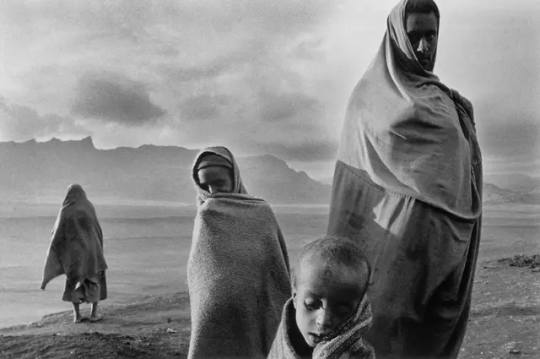
Refugees in the Korem Camp, Ethiopia, 1984.Photograph by Sebastião Salgado / Amazonas Images / Contact Press Images / Peter Fetterman Gallery
Salgado was born in the Brazilian municipality of Aimorés, in the state of Minas Gerais, in 1944. He grew up on a cattle ranch alongside seven sisters, and as a young man he became an avowed Marxist. After a military coup in 1964, he and his wife, Lélia, fled to Paris, where he completed coursework for a Ph.D. in economics from the Sorbonne, before taking a job in London at the International Coffee Organization. He stumbled into photography after borrowing a camera Lélia had purchased to aid in her studies to become an architect, and became so quickly enamored that, soon enough, he built a darkroom in their apartment. After some debate, he turned down a job offer with the World Bank and resolved to become a photographer.
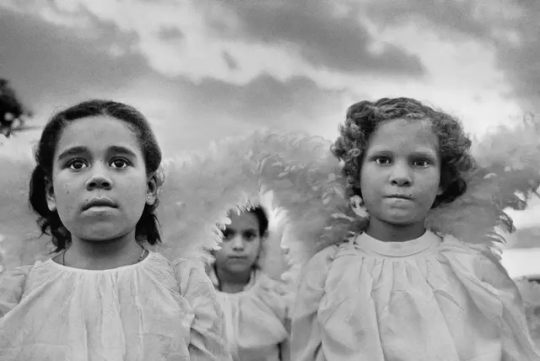
First Communion in Juazeiro do Norte, Brazil, 1981.Photograph by Sebastião Salgado / Amazonas Images / Contact Press Images / Yancey Richardson Gallery
Within a few years of working as a peripatetic photojournalist, during which he covered a handful of minor conflicts and standard-issue fare such as golf tournaments, Salgado secured a spot with the legendary photo agency Magnum, in 1979. (He later broke with Magnum to found his own agency with Lélia, Amazonas Images, which exclusively represented his work.) In 1981, on assignment covering the early days of the first Reagan Administration, he took a career-making series of pictures of the aftermath of John Hinckley, Jr.,’s assassination attempt, which were picked up by newspapers across the globe—and the financial windfall from these shots allowed him to purchase the Paris apartment that he lived in with his wife until his death. But Salgado undertook his most ambitious projects independently.

Eastern Part of the Brooks Range, Alaska, 2009.Photograph by Sebastião Salgado / Amazonas Images / Contact Press Images / Yancey Richardson Gallery
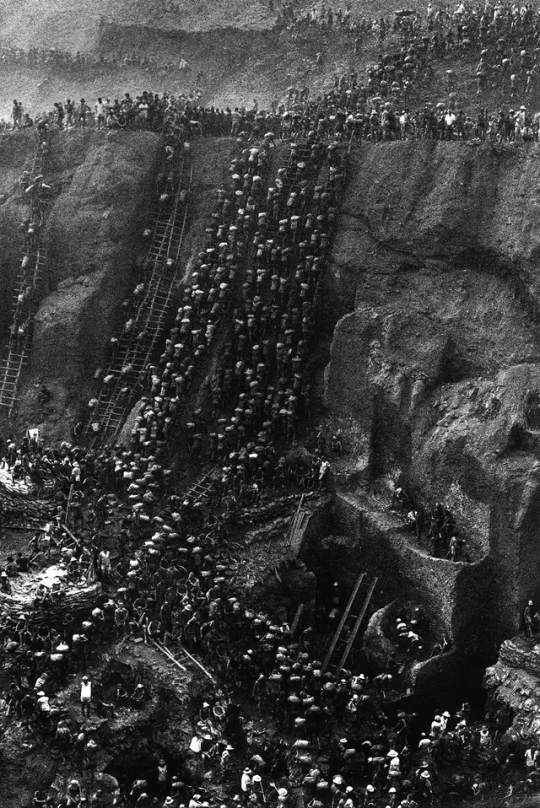
Gold mine, Serra Pelada, Brazil, 1986.Photograph by Sebastião Salgado / Amazonas Images / Contact Press Images / Peter Fetterman Gallery
“Workers: An Archaeology of the Industrial Age,” the first of three mammoth series completed over nearly three decades, was an attempt to commemorate manual labor at a time of rapid mechanization. The pictures, which were taken in twenty-six countries, cover an exotic range of human endeavors, including the production of perfume in Réunion, the quelling of the Kuwaiti oil fires, and, most famously, the toils of gold miners in Serra Pelada, Brazil. Overwhelmingly, the pictures portrayed manual work as a noble, even romantic enterprise. In one, we see a Galician fisherman perched at the head of a small, crowded boat, staring into the middle distance with a gravity befitting Odysseus. In another, we see a Bangladeshi ship-breaker dwarfed by the sublimely towering husk of a boat docked on a beach, suggesting an industrial-era update of Caspar David Friedrich’s “The Monk by the Sea.”
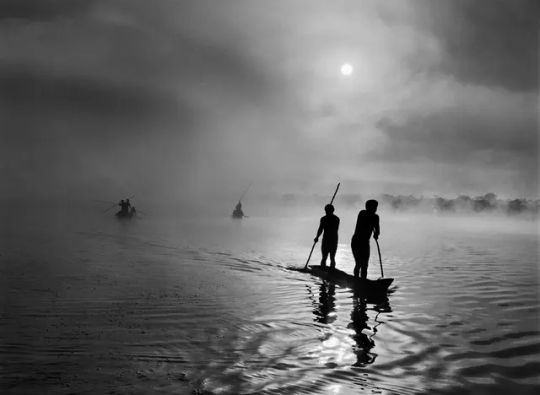
Fishing in the Piulaga Laguna during the Kuarup ceremony of the Waura Group. Upper Xingu Basin, Mato Grosso, Brazil, 2005.Photograph by Sebastião Salgado / Amazonas Images / Contact Press Images / Peter Fetterman Gallery
Sischy, in her critique of Salgado, wrote that his approach to industrial labor shared none of the activist bite of Lewis Hine’s turn-of-the-century pictures of child laborers, which famously played a role in cementing anti-child-labor legislation. Salgado’s “basically uncritical” pictures, Sischy asserted, “would look at home in corporate annual reports.” Like Hine in the latter part of his career, which was largely defined by his heroic, semi-staged photographs of workers, Salgado was principally concerned with portraying the fundamental humanity of his subjects, asserting the value of their work rather than portraying them simply as victims of rapacious exploitation. In this way, they were perhaps closer to Soviet-style socialist realism than they were to boosterish corporate pablum.
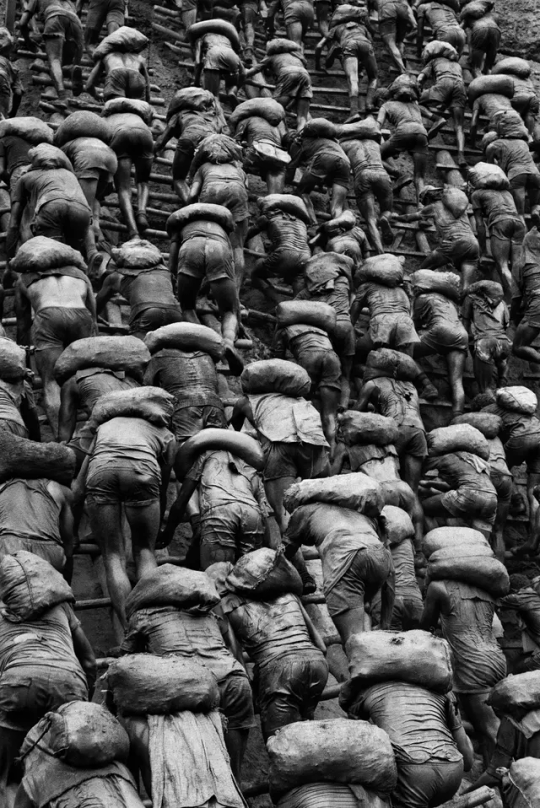
Gold Mine, Serra Pelada, Brazil, 1986.Photograph by Sebastião Salgado / Amazonas Images / Contact Press Images / Yancey Richardson Gallery
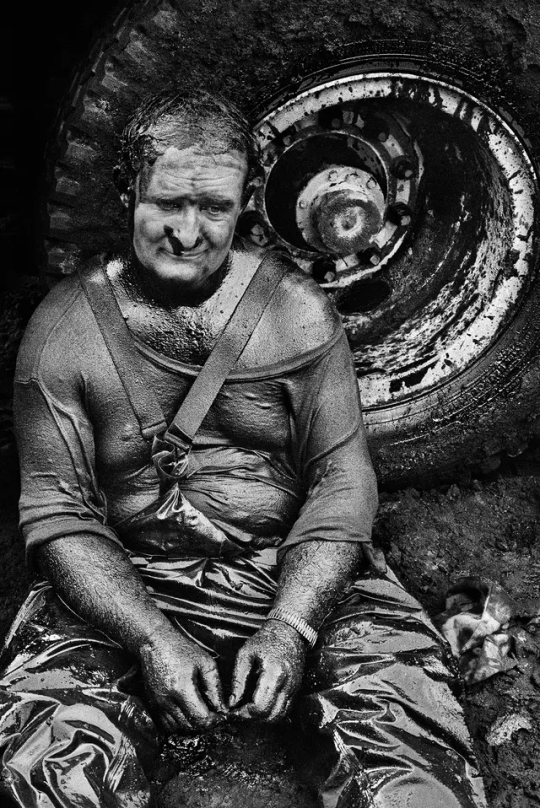
A worker rests after an exhausting day trying to put new heads on the wells. Workers toil in twelve-hour shifts. Kuwait, 1991.Photograph by Sebastião Salgado / Amazonas Images / Contact Press Images / Yancey Richardson Gallery
Last year, on the occasion of Taschen’s reissue of “Workers” (originally published in 1993), I had the chance to interview Salgado over video chat. He was in Paris, sitting in his studio, with a mural-size print of one of his photographs behind him. Salgado had a smooth shaved head and wild white eyebrows. In conversation, he was charming and genial, but he is well practiced in sparring with his critics. “People criticize me that what I do is the beauty of the misery,” Salgado told me. “But I never, I never, photograph the misery. Never. I photograph people that were less rich in material goods. Misery, what is the misery?” His follow-up to “Workers” was a project called “Exodus,” which documented the world’s deracinated people—migrants, exiles, refugees. He spoke to me of the importance of community. “When I photograph the refugees that come out of Malawi, going inside Mozambique—if one of them dies, the others will cry for him. You see they have not a bank account, they have no shoes. But they were proud. They were happy. They have a family that they live inside. And they deserve to have a nice picture. Why not?”
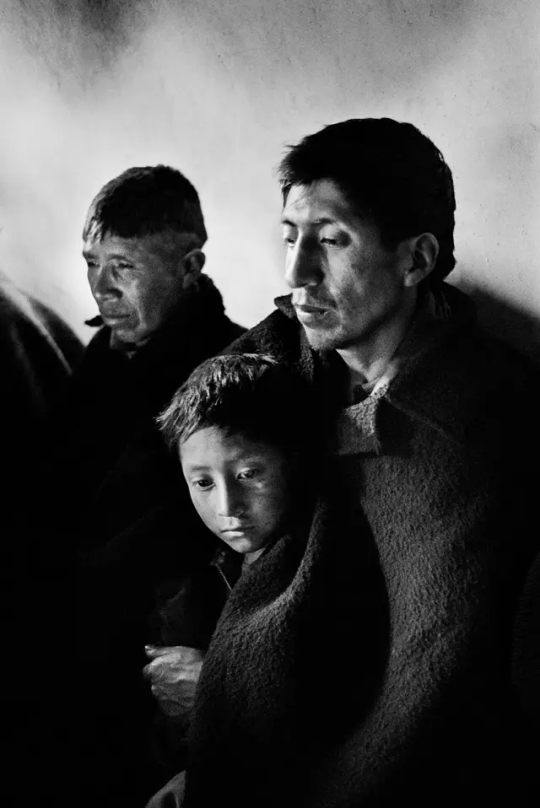
Wake, Village of Alao, Region of Chimborazo, Ecuador, 1998.Photograph by Sebastião Salgado / Amazonas Images / Contact Press Images / Yancey Richardson Gallery
After spending time in Rwandan refugee camps, Salgado told me, he suffered from a series of physical and mental maladies. He saw a doctor back in Paris who told him that, though there was nothing physically wrong, if he kept pursuing his work he would surely die. “I was so upset to be a human being,” he said, “because I saw the amount of violence that we are capable of. We are a terrible species. I gave up photography. I said, ‘Never more in my life I do pictures.’ ” Salgado put his camera away and moved with his wife back to Brazil, to the family cattle ranch, which he had inherited from his father. When they arrived, they found the land nearly denuded of life. Lélia suggested that they might try to rewild it, partly as a form of therapy and partly out of ecological concern. Decades later, what is now called the Instituto Terra is a lush Eden, replete with wildlife and more than two and a half million trees, and serves as a kind of laboratory, providing inspiration for similar projects around the world. “This forest coming back gave me a huge wish to photograph again,” Salgado told me. “And in this moment I said, ‘I go to see my planet.’ I wanted to see what is pristine in this world.”

Zo’e Group, State of Para, Brazil, 2009.Photograph by Sebastião Salgado / Amazonas Images / Contact Press Images / Peter Fetterman Gallery
The resulting eight-year project, “Genesis,” was a paean to natural landscapes and Indigenous ways of living, from Antarctica to the Amazon rain forest. The project is tinged with a tentative note of optimism—look how much of our Earth remains unspoiled—but it also represents a sort of pulling away from humanity. “Before then, I had only faith in humanity,” he told me. “I started to discover that the planet was not composed only of human beings.” Salgado, who is survived by Lélia, their two sons, and two grandchildren, was eighty years old at the time of our conversation. Although he was still occasionally making pictures—he had been trying his hand at drone photography—his days of crafting large-scale projects were over. The waning of Salgado’s career seemed to mark the end of an era of ambitious, essayistic photojournalism, which has been under pressure for more than a decade owing to dwindling print-publication budgets and increased reliance on iPhone-toting “citizen journalists.” Salgado reflected on the privilege of seeing the world as thoroughly as he had. “To see what I see, to have contact where I have—I lived really deep inside the human communities, and I lived deep inside the environment. If it was necessary to start again, I would start exactly as I did before. I had a big pleasure in my life.”
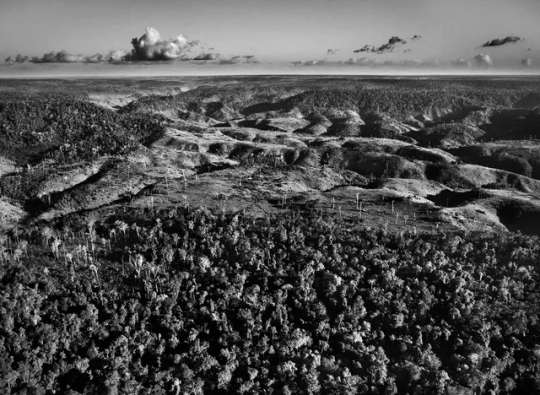
Pico da Neblina, Brazil, 2009.Photograph by Sebastião Salgado / Amazonas Images / Contact Press Images / Peter Fetterman Gallery
5 notes
·
View notes